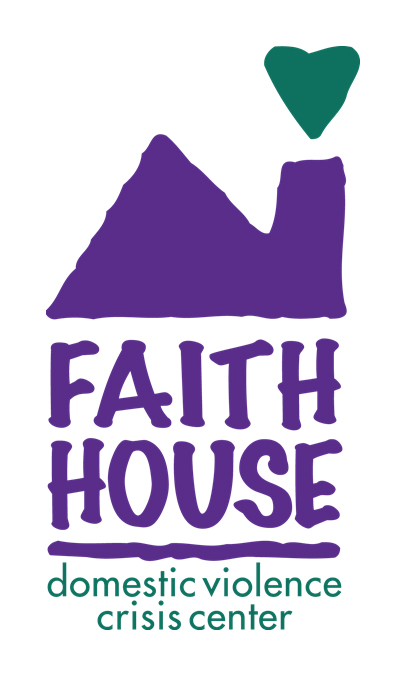Get Help. Be Safe.
Faith House is a private, non-profit program for survivors of domestic violence and their children. The program has seven components: an emergency shelter, a non-residential program, a transitional housing program, a permanent housing program, a 24-hour crisis line, a public education program, and the Family Justice Center of Acadiana.
All of our services are free, confidential, voluntary and available to all individuals experiencing domestic violence.
Do I have to have left my relationship already to access your services?
Emergency Shelter

SLEEPING ARRANGEMENTS
Our shelter currently has ten bedrooms, each has five beds and a bathroom that adjoins two bedrooms, a shared dining room, and living room.

Meals / Cooking
The shelter has a dining room and a large kitchen equipped with a stove, microwave, and sink. Survivors also have access to a stocked refrigerator, freezer, and pantry so that they can cook meals for their family.

LAUNDRY facilities
Residents will have access to onsite laundry facilities. That way you can take care of everything you need from the security and safety of the shelter.

PLAYROOM
A playroom is available for children to enjoy. The playroom is staffed with children’s advocates to oversee the children while playing and provide advocacy. Special events are planned to enhance the child’s experience.

PET accomodations
Faith House, with the help of the Red Rover grant, also houses pets of the survivors. You shouldn’t have to leave your fur babies behind.

SURVIVOR ADVOCATES
Advocates are available daily to speak with survivors and to help set and work on their goals. Our advocates are trained in many areas of domestic violence including safety planning, lethality assessments, the dynamics of domestic violence and the effects of trauma.

Support Groups
Support groups are offered weekly to adults and children.

Medical Advocacy
An on-staff nurse practitioner is available for the care of residents on-site. Medication assistance is available for residents who may have had to leave medication behind when fleeing your situation.

The Family Justice Center of Acadiana provides a multi-disciplinary team of professionals working together, under one roof to effectively respond to domestic violence. The center houses many partners, but the basic partners are law enforcement, prosecutors, civil legal service providers, and community-based advocates.
The core concept is to provide one place where victims can go to talk to an advocate, plan for their safety, interview with a police officer, meet with a prosecutor, receive civil legal assistance, and receive information on shelter.
Check Your Tech
While you browse this site, please keep your personal safety in mind.
Here are some ways to ensure your safety on your computer or phone.
Safety Planning
A safety plan is a personalized, practical plan that includes ways to remain safe while in a relationship, planning to leave, or after you leave. Developing a good safety plan is essential. It will contain all of the vital information you need and be tailored to your unique situation.
Even though including small details may seem obvious, it’s important to remember that in moments of crisis, your brain doesn’t function the same way as when you are calm. When adrenaline is pumping through your veins, it can be hard to think clearly or make logical decisions about your safety — having a safety plan laid out in advance can help you to protect yourself in those stressful moments.
- Identify your partner’s use and level of force so that you can assess the risk of physical danger to you and your children before it occurs.
- Identify safe areas of the house where there are no weapons and there are ways to escape. If arguments occur, try to move to those areas.
- Don’t run to where the children are, as your partner may hurt them as well.
- If violence is unavoidable, make yourself a small target. Dive into a corner and curl up into a ball with your face protected and arms around each side of your head, fingers entwined.
- If possible, have a phone accessible at all times and know what numbers to call for help. Know where the nearest public phone is located. Know the phone number to your local shelter. If your life is in danger, call the police.
- Let trusted friends and neighbors know of your situation and develop a plan and visual signal for when you need help.
- Teach your children how to get help. Instruct them not to get involved in the violence between you and your partner. Plan a code word to signal to them that they should get help or leave the house.
- Tell your children that violence is never right, even when someone they love is being violent. Tell them that neither you, nor they, are at fault or are the cause of the violence, and that when anyone is being violent, it is important to stay safe.
- Practice how to get out safely. Practice with your children.
- Plan for what you will do if your children tells your partner of your plan or if your partner otherwise finds out about your plan.
- Keep weapons like guns and knives locked away and as inaccessible as possible.
- Make a habit of backing the car into the driveway and keeping it fueled. Keep the driver’s door unlocked and others locked — for a quick escape.
- Try not to wear scarves or long jewelry that could be used to strangle you.
- Create several plausible reasons for leaving the house at different times of the day or night.
Statistics show that up to 65% of domestic violence victims are unable to escape their abusive partners because they are concerned about what will happen to their pets when they leave. Fortunately, there are more and more resources in place to assist with this difficult situation.
If you’re creating a safety plan of your own to leave an abusive relationship, safety planning for your pets is important as well. Bring extra provisions for them, copies of their medical records and important phone numbers.
If possible, don’t leave pets alone with an abusive partner. If you are planning to leave, talk to friends, family or your veterinarian about temporary care for your pet. If that is not an option, our center allows for pets to stay with residents of our shelter.
Take steps to prove ownership of your pet: have them vaccinated and license them with your town, ensuring that these registrations are made in your name (change them if they aren’t).
Pregnancy is a time of change. Pregnancy can be full of excitement but also comes with an added need for support. It’s natural to need emotional support from a partner, as well as perhaps financial assistance, help to prepare for the baby and more.
If your partner is emotionally or physically abusive toward you, it can make these months of transition especially difficult. Thankfully, there are resources available to help expecting women get the support needed for a safe, healthy pregnancy.
According to the CDC, intimate partner violence affects approximately 1.5 million women each year and affects as many as 324,000 pregnant women each year. Pregnancy can be an especially dangerous time for women in abusive relationships, and abuse can often begin or escalate during pregnancy.
How can you get help?
- If you’re pregnant, there is always a heightened risk during violent situations. If you’re in a home with stairs, try to stay on the first floor. Getting into the fetal position around your stomach if you’re being attacked is another tactic that can be instrumental in staying safe.
- Doctor’s visits can be an opportunity to discuss what is going on in your relationship.
- If your partner goes to these appointments with you, try to find a moment when they’re out of the room to ask your care provider (or even the front desk receptionist) about coming up with an excuse to talk to them one-on-one.
- If you’ve decided to leave your relationship, a health care provider can become an active participant in your plan to leave.
- If possible, see if you can take a women-only prenatal class. This could be a comfortable atmosphere for discussing pregnancy concerns or could allow you to speak to the class instructor one-on-one.
Often, the emphasis is placed on planning around physical safety, but it’s important to consider your emotional safety as well. Emotional safety can look different for different people, but ultimately it’s about developing a personalized plan that helps you feel accepting of your emotions and decisions when dealing with abuse. Below are some ideas for how to create and maintain an emotional safety plan that works for you.
Seek Out Supportive People
Identify and Work Towards Achievable Goals
Create a Peaceful Space for Yourself
Remind Yourself of Your Great Value
Remember That You Deserve to Be Kind to Yourself
Because violence could escalate when someone tries to leave, here are some things to keep in mind before you leave:
- Keep any evidence of physical abuse, such as pictures of injuries.
- Keep a journal of all violent incidences, noting dates, events, and threats made, if possible. Keep your journal in a safe place.
- Know where you can go to get help. Tell someone what is happening to you.
- If you are injured, go to a doctor or an emergency room and report what happened to you. Ask that they document your visit.
- Plan with your children and identify a safe place for them, like a room with a lock or a friend’s house where they can go for help. Reassure them that their job is to stay safe, not to protect you.
- Contact us and find out about laws and other resources available to you before you have to use them during a crisis.
- Acquire job skills or take courses at a community college as you can.
- Try to set money aside or ask friends or family members to hold money for you.
Make a plan for how and where you will escape quickly. You may request a police escort or stand-by when you leave. If you have to leave in a hurry, use the following list of items as a guide to what you need to bring with you. Our advocates can help you come up with a personalized safety plan for leaving.
1) Identification
- Driver’s license
- Birth certificate and children’s birth certificates
- Social security cards
- Financial information
- Money and/or credit cards (in your name)
- Checking and/or savings account books
2) Legal Papers
- Protective order
- Copies of any lease or rental agreements, or the deed to your home
- Car registration and insurance papers
- Health and life insurance papers
- Medical records for you and your children
- School records
- Work permits/green Card/visa
- Passport
- Divorce and custody papers
- Marriage license
3) Emergency Numbers
- Your local police and/or sheriff’s department
- Your local domestic violence program or shelter
- Friends, relatives, and family members
- Your local doctor’s office and hospital
- County and/or District Attorney’s Office
4) Other
- Medications
- Extra set of house and car keys
- Valuable jewelry
- Pay-as-you-go cell phone
- Address book
- Pictures and sentimental items
- Several changes of clothes for you and your children
- Emergency money
Your safety plan should include ways to ensure your continued safety after leaving an abusive relationship. Here are some safety precautions to consider:
- Change your locks and phone number.
- Call the telephone company to request caller ID. Ask that your phone number be blocked so that if you call anyone, neither your partner nor anyone else will be able to get your new, unlisted phone number.
- Change your work hours and the route you take to work.
- Change the route taken to transport children to school or consider changing your children’s schools.
- Alert school authorities of the situation.
- If you have a restraining order, keep a certified copy of it with you at all times, and inform friends, neighbors and employers that you have a restraining order in effect.
- Call law enforcement to enforce the order and give copies of the restraining order to employers, neighbors and schools along with a picture of the offender.
- Consider renting a post office box or using the address of a friend for your mail (be aware that addresses are on restraining orders and police reports, and be careful to whom you give your new address and phone number).
- Reschedule appointments that the offender is aware of.
- Use different stores and frequent different social spots.
- Alert neighbors and request that they call the police if they feel you may be in danger.
- Replace wooden doors with steel or metal doors. Install security systems if possible.
- Install a motion-sensitive lighting system.
- Tell people you work with about the situation and have your calls screened by one receptionist if possible.
- Tell people who take care of your children or drive them/pick them up from school and activities. Explain your situation to them and provide them with a copy of the restraining order.

